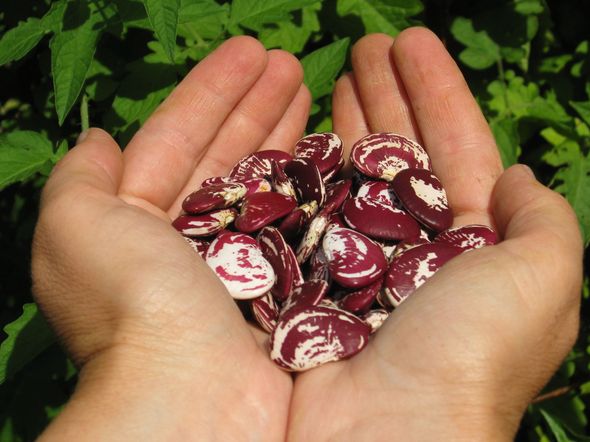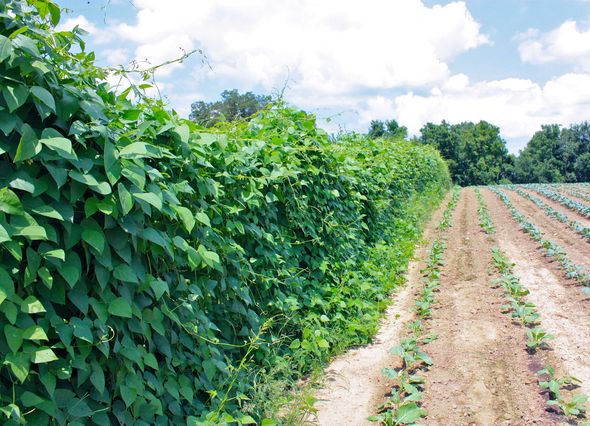Consider the Christmas Lima - cook them simply and enjoy their chestnut-like flavor

Christmas Lima Beans from my garden
Photo | Bob Kuehne
There is a bean that is so delicious and so beautiful that it's hard to decide whether to eat it or just get lost in the batik swirls of carnelian red against its ivory background. This bean is bigger than a thumbnail, with a delicate texture described as akin to a baked potato. You can eat it fresh or dried, and the taste is reminiscent of chestnut.
The only trouble with this gorgeous legume, the Christmas Lima Bean, is that it is a seldom seen bean.
Recently Christmas Limas seemed to be only available dried, via mail order. But Tantre Farm in Chelsea is now growing certified organic Christmas Limas, in addition to several other wonderful Ark of Taste beans — like Cherokee Trail of Tears, Turkey Craw, Jacob's Cattle and Hidatsa Shield Figure beans.
Comparable to a Nobel Prize for foods, the Slow Food Ark of Taste highlights the noteworthiest in "an international catalog of foods threatened by industrial standardization." The international Ark of Taste includes more than 800 vegetables, fruits, berries, nuts, cereals, cheeses, fish, shellfish, livestock, poultry, honeys, spices, syrups and more worldwide, 200 of which have been contributed by the U.S. Ark of Taste.
All are foods that have been painstakingly developed and improved by farmers over generations; these are foods that are expressions of particular places.
Foods included in the Ark of Taste meet the following criteria. They are:
- Outstanding in terms of taste
- At risk biologically or as culinary traditions
- Sustainably produced
- Culturally or historically linked to a specific region, locality, ethnicity or traditional production practice
- Produced in limited quantities, by farms or by small scale processing companies
According to Slow Food USA, the Christmas Lima, said to have originated in Peru, sometimes known as the "Speckled Calico Lima," came to the U.S. in "the 1840s when it was especially popular in the southwestern region of the US. The bean, which is often called the chestnut Lima because of its similarity in taste to the nut, is a large — quarter sized — white, flat seed with maroon spots and swirls. These intricate burgundy designs remain on the bean once it is cooked…They are hardy, heat tolerant and very productive — a bean known for its yield and versatility."

The Great Wall of Christmas Lima Beans at Tantre Farm in August
Photo | Kim Bayer
The first year for Christmas Limas at Tantre Farm was unremarkable — farmer Richard Andres says they just put them in a forgotten corner and didn't really "show them the love." This year, however, Andres planted a 500-foot row of Christmas Limas in well-composted soil, and watered and trellised them.
He now has a towering Great Wall of Christmas Lima beans that have to be harvested and shelled by hand. Deb Lentz, Andres' wife and partner at Tantre Farm says that shelling the beans will be "a wintertime project."
However, if you don't want to take a chance on the delicious beans finally showing up at the farmers' market, you can go out the lovely farm and pick your own. Call first (734-475-4323), and take a bushel basket or a grocery bag. Shelling the big sturdy beans is a fun family project that anyone from age 2 to 92 can do. Andres says they'll probably be $2-3 per pound with the shells on.
Once you get the dried beans shelled, put them in a glass mason jar to admire them. Cook them simply, and enjoy their chestnut-y flavor enhanced with a little butter and salt. Then make one of these Christmas Lima recipes from the NY Times, considering the history and the heroic effort that went into creating this amazing food.
Kim Bayer is a freelance writer and culinary researcher. She would love any news about interesting local food and agriculture efforts. Email her at kimbayer at gmail dot com.

